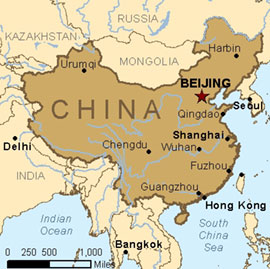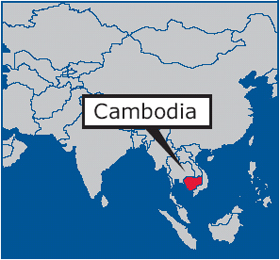Make some food. Pffft. (Yes. I agree. My puns are exceptionally poor, lately.)
China was really difficult for this project—so. Much. Food. Lots of regional cuisine, because China is pretty big, and doesn’t really have a history of being super connected. I mean.
Look. I don’t even know what to say about China. So here’s the Yangtze River, as discovered by Louis CK in the “Louie” Season 3 finale, which in itself is a thing of beauty:
China is really big, really old, really complicated. I can’t possible choose an angle: there’s so much to say about China. It’s so very, very different from the parts of the world I live and have been. I guess I’ll just say: maybe watch this documentary on Ai Weiwei.
Blech. BUT. That’s the thing: such an ancient, complicated and important place is bound to have a ton of interesting food. And food is so important to the culture. Rice. Noodles. Pork, which apparently makes up ¾ of the countries entire meat consumption. THAT’S A LOT OF PIG.
Let us be clear, here, by the way: what you get at your local Chinese restaurant is not what people eat in China. I really hope you knew that already, but it’s worth saying again that American Chinese food is not Chinese food. That’s ok! I love my local Singapore Mei Fun and egg rolls, too. But it’s not the same.
So we tried to go kind of traditional, a dish you would really find in Beijing, or Szechuan. Hot & Sour soup is where we landed, and it was a delicious landing, indeed! This isn’t some lazy packet mix, either, friends—take the time to do it right, coaxing the flavor out, the heat, the sour… and it’s a magical thing.
½ lb ground pork
3 tsp soy sauce
handful of small, dried mushrooms (see what you can find…)
1 ½ tbsp cornstarch
8 oz. can sliced bamboo shoots, cut lengthwise into slivers
2 tbsp red wine vinegar
2 tbsp white vinegar (you’re supposed to use rice vinegar, but at the time we didn’t have any so we went with white—I think rice vinegar would be awesome, too)
1 ½ tsp sugar
1 tsp salt
2 tbsp peanut oil
4 cups chicken broth (best if you make it yourself!!!)
4 oz firm tofu, rinsed & drained, cut into long slices (our were pretty crude)
1 large egg
2 tsp sesame oil
1 ½ tsp white pepper
scallions, sliced or chopped to your liking for garnishability
fresh cilantro
- Coat the pork with about 2 tbsp of the soy sauce—you can also use strips of pork, we just happened to use ground pork, by the by.
- Soak the dried mushrooms in hot water, for about 20-30 minutes. Turn ‘em around from time to time, make sure they’re all covered and soakalicious.
- Remove the mushrooms from the water—don’t toss the water, though! Squeeze out moisture from the caps, remove any hard pieces of stem. Depending on what kind of mushrooms you end up with, you might want to throw out the stems altogether if they’re the gnarly type. Thinly slice the mushrooms.
- Take ¼ cup of the soaking liquid, mix with the cornstarch.
- In a small pan, cover the bamboo shoots with cold water (an inch or two), bring to a boil, then drain (this is to banish some of the bitterness!).
- In another bowl, stir together the vinegars, rest of the soy sauce, sugar, and salt.
- NOW IT’S TIME TO WOK. Do you have one? If not, make do with something else, yeesh. So: heat the wok over a high flame, because that’s how woks work. Pour the peanut oil in and swirl around to coat the whole wok.
- Throw in the pork and stir fry, this will not take long—a minute at most!
- Add mushrooms and bamboo shoots, fry fry for a minute.
- Add the broth, bring to a boil, then add the tofu.
- When it’s back to a boil, add your delicious vinegar mix, then the cornstarch mixture (maybe give that a quick stir in case it got clumpy sitting around). Once it’s boiling again, bring the heat down to keep a simmer.
- Beat the eggs in a bowl with a few drops of the sesame oil. Stir the soup slowly in one direction and drizzle the egg in, and watch it cook into little threads! So pretty!
- Add white pepper, and the rest of the sesame oil. AND WHAM.
- Toss some into bowls, throw some scallions and cilantro on top, and POW. THIS SOUP WAS SO GOOD I CAN’T EVEN EXPLAIN.
I’m really NOT the biggest non-chunky soup person. Hot & sour soup is something I never order—I’ll have it if it’s there, I don’t dislike it, but man. I still dream about this soup, it was so, so so so good. The picture is (unsurprisingly… I should get an actual camera and learn how to use it one day) not very good and it looks kinda oily, but I assure you: none of that mattered a single bit. SO. GOOD.
Like, REALLY GOOD.








